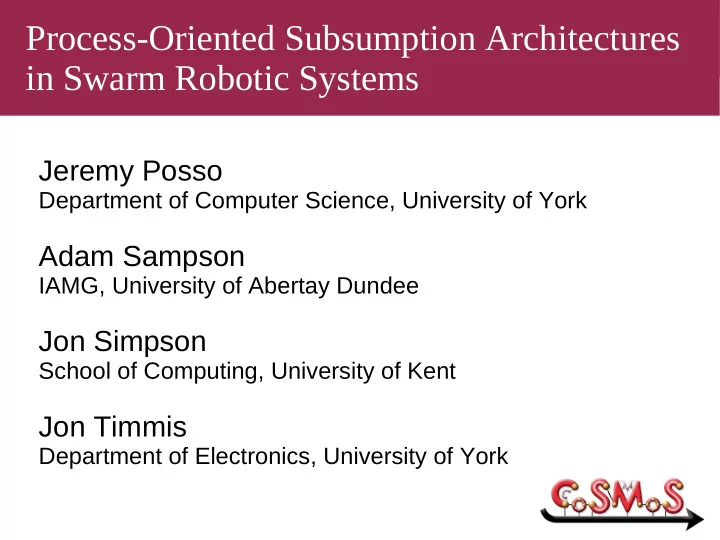

Process-Oriented Subsumption Architectures in Swarm Robotic Systems Jeremy Posso Department of Computer Science, University of York Adam Sampson IAMG, University of Abertay Dundee Jon Simpson School of Computing, University of Kent Jon Timmis Department of Electronics, University of York
Introduction ● Jeremy Posso's MSc project at York in 2009 – Supervised by Jon Timmis – Worked with Jon Simpson on architecture, and Adam Sampson on Player/Stage bindings ● Robotic control is an inherently concurrent problem: sensors, actuators... ● Process-oriented programming should be a convenient way to implement control systems – Transterpreter, Plumbing...
Subsumption architecture ● Layered behaviours – Map sensor inputs turn on AC to actuator outputs open windows ● Suppressors Sensor Actuators close windows ● Inhibitors data ● No planning – Suppress purely reactive S Behavioural ● Modular √ module I Compositional ? Inhibit
Past work ● CPA 2006 : Simpson, Jacobsen and Jadud, “Mobile Robot Control: the Subsumption Architecture and occam-π” – Implemented subsumptive control components in a process-oriented system ● CPA 2009 : Simpson and Ritson, “Toward Process Architectures for Behavioural Robotics” – Compared subsumption with other approaches; identified scalability problems
Swarm robotics ● Several robots collaborate to perform a task – May involve engineering emergence ● Local intelligence, not remote control ● Robustness ● Flexibility ● How can we use a process-oriented subsumptive control system in a swarm context?
The task ● Foraging: common swarm problem ● Many identical robots collect pieces of rubbish from a field, and deposit them in a bin ● Robots must coordinate to avoid collisions, while covering as much ground as possible ● Robots have limited battery life – must recharge at charging stations when low
The robot ● Pioneer platform, modelled within Stage – Realistic, noisy... so nondeterministic ● Gripper for collecting rubbish ● Camera for spotting rubbish, other robots, chargers and the bin – Rubbish is red, robots are blue... ● Sonar for avoiding walls, etc. ● All driven through the Player library – … which Jeremy significantly improved our bindings to
Design ● First we identify the high-level behaviours – Arrange in priority order, most important last ● Explore ● Avoid collisions ● Acquire rubbish ● Deposit rubbish ● Recharge ● Collaborate
Design ● Then we can break those down into simpler behaviours, and map those to processes ● e.g. Avoid collisions – Move forwards – … unless you're about to run into something – If sonar senses something to one side, turn away from it
The control system
The process network (see paper for more detail)
Trials ● Four robots, sixteen pieces of rubbish ● Success when all rubbish in bin within twenty minutes
Video
Results ● Ran 20 trials... ● … of which only 5 were completely successful ● It works sometimes – why not always?
Diagnosis ● Some robots wander around but don't pick up or put down rubbish... ● Some behaviours aren't working ● Part of the control system has deadlocked ● … but no way to detect this until it's used ● This appears to be a common problem with complex subsumptive controllers
Desiderata ● Synchronous channels aren't a good fit here – we want overwriting-buffered channels – Can we identify new design patterns for safe programming with asynchronous communications? ● We don't have good tools for debugging or performance analysis (e.g. tracking latency) – The Transterpreter can give you the data... – … we just need to display/explore it
Conclusion ● We've built a complex subsumptive control system using process-oriented techniques ● Design and implementation straightforward ● It works... sometimes! – We need better tools to tune and debug it ● Previous attempts at subsumption in occam-π built much simpler systems, and didn't run into these scalability problems
Future work ● Build subsumptive swarm systems that span multiple robots – e.g. allow one robot to suppress behaviours in another robot ● Investigate other approaches for complex problems like this – e.g. Colony architecture Any questions?
Recommend
More recommend